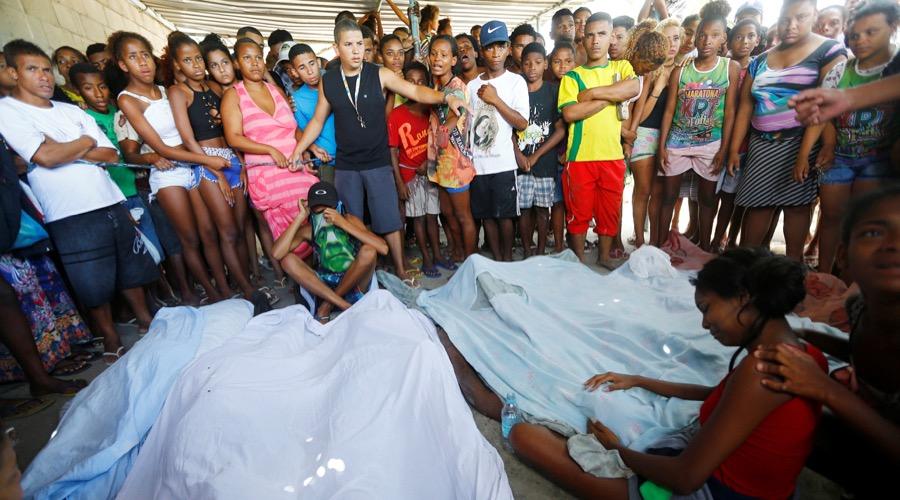Charts: Crime is getting even worse in post-Olympics Rio
Residents gather round the bodies of suspected drug traffickers in the City of God favela in Rio de Janeiro on Nov. 20.
During the Summer Olympic Games, Rio de Janeiro deployed 85,000 troops and police officers to watch over the tourists and athletes who flooded into the city. For a little while it resembled a military takeover, with clusters of armed soldiers every few blocks.
But now, those troops are gone. Not just that, but Rio’s city and state administrations are broke. The cops who remain are receiving their salaries in late installments because the authorities can’t afford to pay them on time.
Anecdotally, violence and crime keep are getting worse. Recent clashes between police and drug traffickers in the city’s impoverished favela neighborhoods have resulted in dozens of shootings. Last month, a police helicopter crashed in the gritty City of God favela, killing four officers.
And now, new official statistics from Rio’s Public Security Institute show that the city is, indeed, facing a severe surge in crime from just last year.
We’ve put together three charts that illustrate some of the most shocking numbers.
1. Street robberies are up 48 percent from last year
From January to October, there were over 30,000 more robberies reported in Rio than in the first 10 months of 2015 — a whopping 48 percent increase.
As Brazil’s economy craters, Rio has been hit especially hard. The city and state once had a booming oil industry, but thousands of jobs have been lost following the meltdown of the state oil company, Petrobras, which is caught in a massive corruption scandal.
Drug gangs are also making a forceful return to the favelas, leading to a rise in everything from petty crime to murders, says Silvia Ramos, a sociologist at the Center for Security and Citizenship Studies at Rio’s Candido Mendes University.
Ramos says a “pacification” program, that sent thousands of military police to “invade” and set up permanent commands in the favelas, has proved a comprehensive failure.
“There’s no doubt at this point that we are living in a situation where the drug bosses are coming back and we’re seeing a big increase in violent and other crime that is very similar to what we had before the UPPs,” Ramos says, using the Portuguese initials for the police occupation.
2. Deadly assaults are way up — that includes police-involved killing
In the first 10 months of 2016, crimes involving deadly force — including deliberate killing, "bodily injury followed by death" and "homicide resulting from opposing police intervention" (literal translations from the Portuguese crime labels) — jumped 21 percent compared with the same period in 2015.
Ramos says this is almost certainly a result of the breakdown of the pacification program. As narco-traffickers become more confident and reclaim their old territory, Rio is regressing to the bad old days of turf wars between rival gangs and fierce police pursuits of drug bosses inside the favelas.
“What is pretty much dead at this point is the whole idea of ‘pacification,’” Ramos says. “The idea that if you put a permanent presence in the favela, you won’t have a permanent presence of traffickers using weapons of war.”
3. Homicides are up 18 percent
Rio de Janeiro recorded more than 600 more homicides in the first 10 months of 2016 than it did in the same period last year, an increase of 18 percent.
To put Rio’s murder numbers in perspective, let’s compare it to Chicago, where gun violence and murder have grabbed lots of attention lately. Chicago had 474 murders in the first eight months of 2016, a shocking 50 percent increase from last year.
Rio, with about double the population of Chicago, had 3,649 murders in that time period, almost eight times as many.
